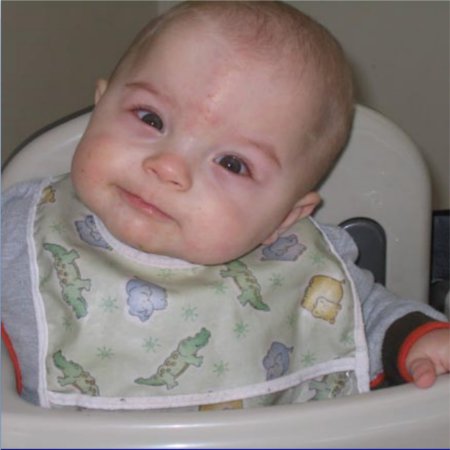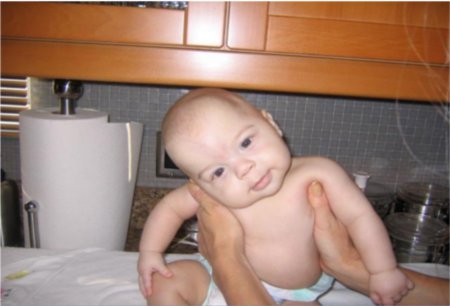基底节在控制运动中发挥着重要的作用。皮质-基底节-丘脑-皮层之间的回路建立了基底节功能的解剖基础。肌张力不全是由于回路兴奋性和抑制性信号不平衡。在这些回路中发挥重要作用的神经递质包括GABA,谷氨酸和多巴胺。[6]Mink JW. Functional anatomy of the basal ganglia. In: Stacy MA, ed. Handbook of dystonia. New York, NY: Informa Healthcare; 2007:45-56.
在所有肌张力不全的病例中,大约45%是原发性,55%是继发性。
原发性婴儿肌张力不全
原发性肌张力不全不是由于获得性损害或代谢和遗传变性病引起。肌张力不全是唯一的症状,没有中枢神经系统结构的异常。 [Figure caption and citation for the preceding image starts]: 婴儿良性阵发性斜颈由Kenneth Silver医生收集;使用需得到允许。 [Citation ends].
[Figure caption and citation for the preceding image starts]: 婴儿良性阵发性斜颈由Kenneth Silver医生收集;使用需得到允许。 [Citation ends]. [Figure caption and citation for the preceding image starts]: 婴儿良性阵发性斜颈由Kenneth Silver医生收集;使用需得到允许。 [Citation ends].其病因可能是遗传的或未知的。可能有肌张力不全的家族史。在原发性肌张力不全中,原发性扭转型肌张力不全(特发性扭转型肌张力不全,Oppenheim肌张力不全)是由于DYT1基因编码区3个碱基对的缺失(CAG)引起,此基因位于染色体9q34。[7]Ozelius L, Kramer PL, Moskowitz CB, et al. Human gene torsin dystonia located on chromosome 9q32-q34. Neuron. 1989;2:1427-1434.http://www.ncbi.nlm.nih.gov/pubmed/2576373?tool=bestpractice.comDYT1基因编码蛋白torsinA,这种蛋白质在黑质致密部,海马的颗粒和锥体细胞,小脑的浦肯野细胞和齿状核神经元,纹状体胆碱能神经元这些分泌多巴胺的神经元中高表达。[8]Rostasy K, Augood SJ, Hewett JW, et al. TorsinA protein and neuropathology in early onset generalized dystonia with GAC deletion. Neurobiol Dis. 2003;12:11-24.http://www.ncbi.nlm.nih.gov/pubmed/12609485?tool=bestpractice.com它的功能还不清楚。研究表明TorsinA蛋白可能:
[Figure caption and citation for the preceding image starts]: 婴儿良性阵发性斜颈由Kenneth Silver医生收集;使用需得到允许。 [Citation ends].其病因可能是遗传的或未知的。可能有肌张力不全的家族史。在原发性肌张力不全中,原发性扭转型肌张力不全(特发性扭转型肌张力不全,Oppenheim肌张力不全)是由于DYT1基因编码区3个碱基对的缺失(CAG)引起,此基因位于染色体9q34。[7]Ozelius L, Kramer PL, Moskowitz CB, et al. Human gene torsin dystonia located on chromosome 9q32-q34. Neuron. 1989;2:1427-1434.http://www.ncbi.nlm.nih.gov/pubmed/2576373?tool=bestpractice.comDYT1基因编码蛋白torsinA,这种蛋白质在黑质致密部,海马的颗粒和锥体细胞,小脑的浦肯野细胞和齿状核神经元,纹状体胆碱能神经元这些分泌多巴胺的神经元中高表达。[8]Rostasy K, Augood SJ, Hewett JW, et al. TorsinA protein and neuropathology in early onset generalized dystonia with GAC deletion. Neurobiol Dis. 2003;12:11-24.http://www.ncbi.nlm.nih.gov/pubmed/12609485?tool=bestpractice.com它的功能还不清楚。研究表明TorsinA蛋白可能:
参与内质网膜的转运
保护细胞免受过氧化氢的毒性
作为蛋白质降解的分子伴侣蛋白
影响纹状体多巴胺信号传递。
在肌张力不全患者的脑的黑质和纹状体中并没有发现torsinA染色差异或病理的异常。在CAG缺失的肌张力不全的患者脑内多巴胺神经元似乎排列更紧密。这些发现提示神经元功能的改变。[9]Siegert S, Bahn E, Kramer ML, et al. TorsinA expression is detectable in human infants as young as 4 weeks old. Brain Res Dev Brain Res. 2005;157:19-26.http://www.ncbi.nlm.nih.gov/pubmed/15939081?tool=bestpractice.com
多巴反应性肌张力障碍(即 Segawa 综合征、昼夜波动性肌张力障碍帕金森病)具有异质性。常见的遗传方式为常染色体显性遗传。基因定位于染色体14q22.1-q22.2,编码GTP-cyclohydrolase-I,这是四氢叶酸合成中的限速酶。[10]Ichinose H, Ohye T, Takahashi E, et al. Hereditary progressive dystonia with marked diurnal fluctuation caused by mutations in the GTP cyclohydrolase I gene. Nat Genet. 1994;8:236-242.http://www.ncbi.nlm.nih.gov/pubmed/7874165?tool=bestpractice.com一种少见的遗传方式为常染色体隐性遗传,定位于染色体11p15.5,编码酪氨酸羟化酶,是儿茶酚胺类多巴胺,去甲肾上腺素,肾上腺素合成过程中的限速酶。[11]Ludecke B, Dworniczak B, Bartholome K. A point mutation in the tyrosine hydroxylase gene associated with Segawa's syndrome. Hum Genet. 1995;95:123-125.http://www.ncbi.nlm.nih.gov/pubmed/7814018?tool=bestpractice.com其他形式的四氢叶酸合成缺陷引起多巴反应性肌张力不全,如6-丙酮酰四氢蝶呤合成酶,二氢喋呤还原酶,和墨蝶呤合成酶。这些酶在合成和分解生物单胺神经递质,多巴胺,去甲肾上腺素中发挥重要作用。[4]Kamal N, Bhat DP, Carrick E. Dopa-responsive dystonia (Segawa syndrome). Indian Pediatr. 2006;43:635-638.http://www.indianpediatrics.net/july2006/635.pdfhttp://www.ncbi.nlm.nih.gov/pubmed/16891685?tool=bestpractice.com
最近的研究发现了其他少见的引起婴幼儿肌张力不全的神经学发现和基因突变,包括:
阵发性运动诱发的运动障碍与常染色显性遗传的SLC2A1基因突变以及血脑葡萄糖转运的GLUT1基因突变有关。[12]Suls A, Dedeken P, Goffin K, et al. Paroxysmal exercise-induced dyskinesia and epilepsy is due to mutations in SLC2A1, encoding the glucose transporter GLUT1. Brain. 2008;131:1831-1844.https://academic.oup.com/brain/article/131/7/1831/389036/Paroxysmal-exercise-induced-dyskinesia-andhttp://www.ncbi.nlm.nih.gov/pubmed/18577546?tool=bestpractice.com
婴幼儿帕金森肌张力不全和常染色体隐性遗传的SLC6A3基因突有关。这导致了多巴胺转运体(DAT)水平的下降,这些转运体介导神经元外多巴胺的再摄取。[13]Kurian MA, Zhen J, Cheng S-Y, et al. Homozygous loss-of-function mutations in the gene encoding the dopamine transporter are associated with infantile parkinsonism-dystonia. J Clin Invest. 2009;119:1595-1603.http://www.jci.org/articles/view/39060http://www.ncbi.nlm.nih.gov/pubmed/19478460?tool=bestpractice.com
肌阵挛肌张力不全综合征(DYT11)和常染色体显性杂合SGCE基因突变有关,它编码的物质通常结合于跨膜肌萎缩蛋白糖蛋白复合体上。[14]Asmus F, Langseth A, Doherty E, et al. "Jerky" dystonia in children: spectrum of phenotypes and genetic testing. Mov Disord. 2009;24:702-709.http://www.ncbi.nlm.nih.gov/pubmed/19117362?tool=bestpractice.com
儿童交替性偏瘫和ATP1A3基因突变有关。[15]Heinzen EL, Swoboda KJ, Hitomi Y, et al. De novo mutations in ATP1A3 cause alternating hemiplegia of childhood. Nat Genet. 2012;44:1030-1034.http://www.ncbi.nlm.nih.gov/pmc/articles/PMC3442240/http://www.ncbi.nlm.nih.gov/pubmed/22842232?tool=bestpractice.comATP1A3基因的突变也在婴儿新的快速起病的肌张力不全帕金森综合征中被发现。[16]Brashear A, Mink JW, Hill DF, et al. ATP1A3 mutations in infants: a new rapid-onset dystonia-Parkinsonism phenotype characterized by motor delay and ataxia. Dev Med Child Neurol. 2012;54:1065-1067.http://www.ncbi.nlm.nih.gov/pubmed/22924536?tool=bestpractice.com
发作性运动诱发的肌张力障碍最近在显性遗传的家系中被证实和PRRT2基因突变有关。[17]Wang JL, Cao L, Li XH, et al. Identification of PRRT2 as the causative gene of paroxysmal kinesigenic dyskinesias. Brain. 2011;134:3493-3501.https://academic.oup.com/brain/article/134/12/3493/261459/Identification-of-PRRT2-as-the-causative-gene-ofhttp://www.ncbi.nlm.nih.gov/pubmed/22120146?tool=bestpractice.com
继发性婴儿肌张力不全
继发性肌张力不全由多种获得性病因引起。综合征病例多数由于代谢性疾病引起。[18]Fernández-Alvarez E. Prevalence of paediatric movement disorders. In: Fernández-Alvarez E, Arzimanoglou A, Tolosa E, eds. Paediatric movement disorders. Montrouge, France: John Libbey Eurotext; 2005:1-18.
继发性,遗传性/退行性和继发性,代谢性
许多代谢性和遗传变性疾病通过破坏基底节功能和干扰多巴胺合成导致肌张力不全。影像学检查能发现基底节区的异常。
引起继发性肌张力不全的最常见的代谢性疾病是戊二酸尿症1型。它是由戊二酰辅酶A脱氢酶活性降低引起的,它是一种线粒体基质酶,在赖氨酸,羟赖氨酸和色氨酸的降解中发挥作用。尸检提示纹状体萎缩伴中等大小的神经元严重丢失,大神经元的轻微丢失,脑干白质的海绵样变以及早期阶段轻度的淋巴细胞浸润。神经元损伤发生在脑病后不久且不进展。有机酸作为毒性物质和渗透剂在疾病的发生过程中是重要的。[19]Funk CB, Prasad AN, Frosk P, et al. Neuropathological, biochemical and molecular findings in a glutaric academia type 1 cohort. Brain. 2005;128(Pt 4):711-722.https://academic.oup.com/brain/article/128/4/711/284316/Neuropathological-biochemical-and-molecularhttp://www.ncbi.nlm.nih.gov/pubmed/15689364?tool=bestpractice.com
在线粒体脑病中,Leigh综合征特点是神经元丢失,胶质细胞增生和整体性的双侧对称性坏死性病变,尤其易发生在基底节、丘脑和脑干。[20]Tanji K, Kunimatsu T, Vu TH, et al. Neuropathological features of mitochondrial disorders. Semin Cell Dev Biol. 2001;12:429-439.http://www.ncbi.nlm.nih.gov/pubmed/11735377?tool=bestpractice.com
婴儿癫痫运动障碍性脑病是由于ARX基因部分碱基对扩增引起的。ARX基因的突变通过破坏神经元的迁移引起功能障碍,尤其是GABA能神经元,在这些神经元中碱基对扩增引起突变蛋白的核内聚集从而导致培养皮层神经元的死亡。[21]Nasrallah IM, Minarcik JC, Golden JA. A polyalanine tract expansion in Arx forms intranuclear inclusions and results in increased cell death. J Cell Biol. 2004;167:411-416.http://jcb.rupress.org/content/167/3/411.fullhttp://www.ncbi.nlm.nih.gov/pubmed/15533998?tool=bestpractice.com基底节中GABA能神经元很丰富。MRI上基底节区的空洞表现可能是由纹状体内神经元死亡引起,而这些神经元的死亡是由突变蛋白核内聚集引起。[22]Guerrini R, Moro F, Kato M, et al. Expansion of the first PolyA tract of ARX causes infantile spasms and status dystonicus. Neurology. 2007;69:427-433.http://www.ncbi.nlm.nih.gov/pubmed/17664401?tool=bestpractice.com
继发性,药物/毒物
在药物介导的肌张力不全中,大多数相关的药物是多巴胺受体拮抗剂。他们可能通过基底节区多巴胺受体引起肌张力不全。
继发性,静止性或结构性
在核黄疸中,胆红素引起基底节区选择性的神经毒性,尤其是苍白球和丘脑核,小脑和脑干,通过损伤细胞内钙稳态,诱导线粒体中细胞色素C的释放导致细胞凋亡。[23]Hanko E, Hansen TW, Almaas R, et al. Bilirubin induces apoptosis and necrosis in human NT2-N neurons. Pediatr Res. 2005;57:179-184.http://www.ncbi.nlm.nih.gov/pubmed/15611354?tool=bestpractice.com
类似肌张力不全的情况
各种情况都可表现类似肌张力不全。如继发性婴儿斜颈,由于头颈部感染引起,炎症刺激颈部肌肉、神经和椎骨所致。[24]Bredenkamp JK, Maceri DR. Inflammatory torticollis in children. Arch Otolaryngol Head Neck Surg. 1990;116:310-313.http://www.ncbi.nlm.nih.gov/pubmed/2306349?tool=bestpractice.com
 [Figure caption and citation for the preceding image starts]: 婴儿良性阵发性斜颈由Kenneth Silver医生收集;使用需得到允许。 [Citation ends].
[Figure caption and citation for the preceding image starts]: 婴儿良性阵发性斜颈由Kenneth Silver医生收集;使用需得到允许。 [Citation ends]. [Figure caption and citation for the preceding image starts]: 婴儿良性阵发性斜颈由Kenneth Silver医生收集;使用需得到允许。 [Citation ends].其病因可能是遗传的或未知的。可能有肌张力不全的家族史。在原发性肌张力不全中,原发性扭转型肌张力不全(特发性扭转型肌张力不全,Oppenheim肌张力不全)是由于DYT1基因编码区3个碱基对的缺失(CAG)引起,此基因位于染色体9q34。[7]DYT1基因编码蛋白torsinA,这种蛋白质在黑质致密部,海马的颗粒和锥体细胞,小脑的浦肯野细胞和齿状核神经元,纹状体胆碱能神经元这些分泌多巴胺的神经元中高表达。[8]它的功能还不清楚。研究表明TorsinA蛋白可能:
[Figure caption and citation for the preceding image starts]: 婴儿良性阵发性斜颈由Kenneth Silver医生收集;使用需得到允许。 [Citation ends].其病因可能是遗传的或未知的。可能有肌张力不全的家族史。在原发性肌张力不全中,原发性扭转型肌张力不全(特发性扭转型肌张力不全,Oppenheim肌张力不全)是由于DYT1基因编码区3个碱基对的缺失(CAG)引起,此基因位于染色体9q34。[7]DYT1基因编码蛋白torsinA,这种蛋白质在黑质致密部,海马的颗粒和锥体细胞,小脑的浦肯野细胞和齿状核神经元,纹状体胆碱能神经元这些分泌多巴胺的神经元中高表达。[8]它的功能还不清楚。研究表明TorsinA蛋白可能: